Ubisoft’s third-person shooter The Division has been one of 2016’s most interesting successes and one of its worst fiascoes. The people who make it now hope it can also be the year’s best comeback story.
On Tuesday, the game’s developers will issue a major patch that is designed to do nothing less than overhaul a game that, in the words of the developers, was no longer sufficiently “fun,” especially in its endgame.
Patch 1.4 is Ubisoft’s big hope, a fix meant to arrest the wilting of a player base that has shrunk from millions at launch to scant thousands today. Over the weekend, the game barely clung to a 90-something spot on Steam’s daily activity charts below Counter-Strike, Team Fortress, Doom, Dying Light, the gradually-improved fellow Tom Clancy-branded game Rainbow Six Siege and dozens more.
In March, Ubisoft bragged that The Division was the hottest new franchise they’d ever put out. By August, the game’s developers were announcing that they were postponing the second major expansion in order to revamp the core game..
We’ve covered the highs and lows of The Division since it came out in the spring. We were pleased to find out recently that the game’s creators were interested in talking to Kotaku about the journey they have taken. I got in touch with them over email, firing off a battery of questions to Ubisoft PR reps, who collected answers from Division creators at the game’s main studio Massive, as well as partner studios Red Storm and Reflections. I asked for frank answers. While some of their answers were dodges, the team offered a lot of insight into what their rollercoaster of a year was like and what they have learned from it.
“A very wild and talented teenager”
“In many ways, creating The Division has been like living with a very wild and talented teenager,” David Polfeldt, the managing director at Massive, reflected over email. “It’s been a colourful, complicated, fascinating, jaw-dropping and finally an amazingly rewarding journey. It wasn’t always easy to manage the development, but to be honest, I don’t believe any game of this scale is.”
The Division was announced at E3 2013 with a haunting debut video presentation that described a terrorist attack on New York City that used contaminated money to kill great numbers of holiday shoppers and other civilians, putting the city on lockdown. The Division would be a shared-world shooter set in snowy, lawless New York. The players would fill the boots of a member of a special forces unit called The Division, comprised of regular people who’d been trained to mobilize when urban catastrophe strikes. It wasn’t expected for a year or so and eventually got a 2015 release.
Then, something changed. Early promotion and press previews gave way to silence. Ubisoft’s official blog, for example, didn’t post about the game between July 2014 and May 2015 when it was announced that another studio, Ubisoft Annecy, was joining to help finish the game. The release date slid to 2016.
“We were simply ploughing ahead at full speed to deliver what we had promised at E3 in 2013,” Polfeldt said. “It ended up taking a bit longer than we thought to get everything right.”
The alpha and beta finally started rolling out to the public in late 2015 and early 2016. Even the beta was hot. Players flooded in. Kotaku stories about the beta were surprisingly popular. Absence hadn’t engendered apathy. People were excited for The Division.
Bugs, Exploits, And What Was Actually Worth Fixing
Reviews of The Division when it launched in March were positive, but as soon as the game came out, players started discovering some extraordinary bugs. One memorable issue from launch was the doorway problem. Much of The Division can be experienced solo, but multiple players will all appear in the game’s safe houses.
Players were blocking each other in the doorway to the game’s starter safe house in Brooklyn, clogging a key portal in the beginning area of the game. They could push past each other, but it took a lot of jostling and waiting for the game’s physics to respond.
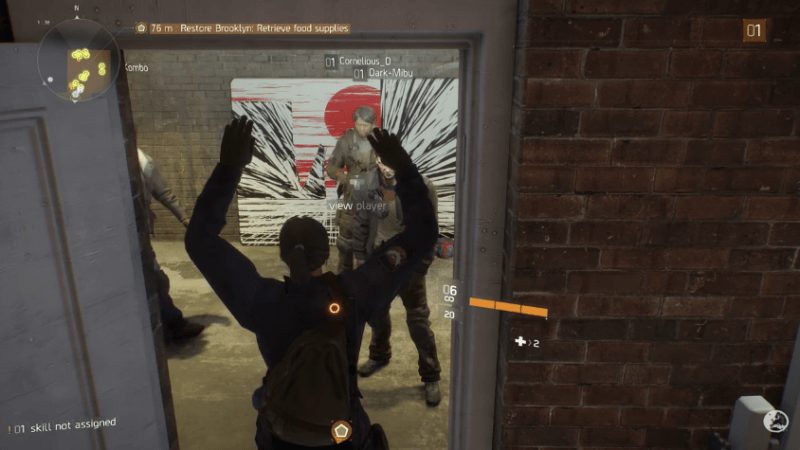
It seemed like the kind of thing testers should have caught. “We gameplay-tested the game, had an Alpha and open Beta and we felt good about the launch,” Massive’s technical director Carl Johan Lejdfors said in an email.
“There were things that we discovered along the way that needed to be addressed, so we prioritised those adjustments and implemented fixes along the way. It has always been possible to push past other players by moving forward for a short time and in the next patch we reduced the time one needed to push before passing another player.”
The doorway problem was a hint of problems and solutions to come. Players, sometimes through willful griefing, trolling and other mischief-making, would find a way to make the game look silly, and the developers would have to respond, not always as soon as they’d like. “We’re looking at ways to shorten the time between flagging a problem area, communicating about it to players and fixing it as quickly as possible,” Lejdfors said.
Exploits kept cropping up. As often happens in loot-based games like The Division,players quickly found ways to exploit the game to farm loot. There was the Bullet King, an enemy who would players could loop into a string of lucrative quick deaths.
There was the trick of shooting enemies in Falcon Lost from outside the map. These were cropping up continuously in the days and weeks after The Division’s launch. They’d pop up and, within a few days, the developers would eliminate the exploit.
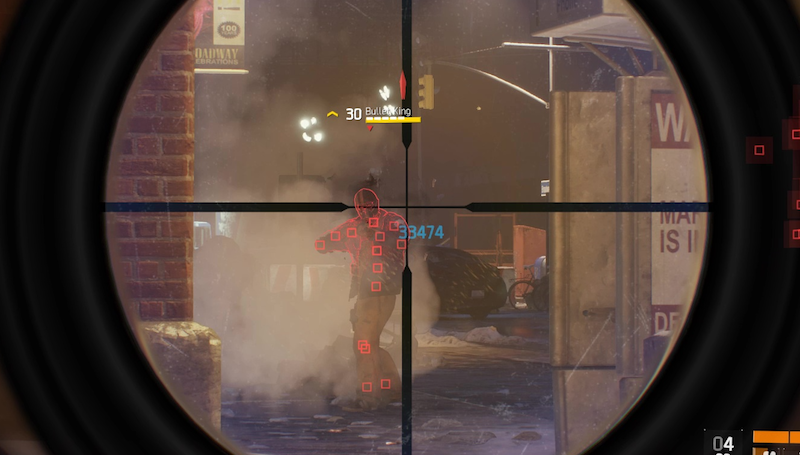
“One of our main philosophies when structuring our live game organisation and online backend was to allow us to be extremely reactive,” online and live operations director Fredrik Bronjemark said. But what to fix? One player’s horrible rule-breaking exploit is another player’s ingenious shortcut to riches. Development studios don’t always agree with their players about which exploits are bad and which should be fixed.
“The way we reasoned, and still do, is that there’s two basic rules,” Bronjemark said. “The first one is: if using the exploit gives a player an unfair advantage compared to other players, it should be fixed. The second rule is if the exploit makes the time you spend in the game less enjoyable, it should be fixed.”
Bronjemark saw common cause with Bungie’s shuttering of Destiny’s so-called loot cave, an area where players discovered they could kill endless streams of enemies to earn more and more loot. “I think the second rule applies to the Destiny loot cave,” he said.
“Using the loot cave exploit wouldn’t actually give you an unfair advantage. Statistically you would get better loot from other activities in the game if you spent an equal amount of time, so players would use the loot cave because it was convenient and effortless. But that’s not the way Bungie had imagined the game to be played.
“The same would apply to some of the Falcon Lost exploits we fixed. You could destroy the APC by shooting at it from outside the map with explosive weapons, but it actually a took longer time than to complete the Incursion the way it was meant to be played. So, even if it didn’t necessarily give you an advantage in terms of faster progression, we still felt this was something we wanted to fix, as it just wasn’t a fun gaming experience.”
Within weeks of release, The Division was infested with cheaters. Some people theorised that the server system Ubisoft used made it hard to stop cheaters, especially on PC, though Bronjemark denies this. In April, the developers laid out plans to penalise cheaters.
Initially, they were going to issue warnings. That didn’t seem to help. In early June, they changed their policy and said they would ban cheaters for a first offence. It was around this April-June timeframe that people seemed to turn on the game. Player counts were dropping and the conventional wisdom was that The Divisionwas overrun with cheaters.
“This was a very hectic period for us as we were at the time constantly catching up with new types of cheats that were emerging,” Bronjemark recalls. “Certainly we had prepared for cheating, but not at the scale that we were facing. There was nothing in our server setup or infrastructure preventing us as it was theorised, it was literally that we had to improve our detection systems to catch the different variations of cheats.
The reason why we moved to the ban on first offence model was that we still saw a lot of those cheaters returning and once again ruining the experience for the non-cheating players. So we decided to take a firm stance and have a zero-tolerance policy on cheating. And this response was welcomed by players immediately.”
The Ingenious, Infuriating Dark Zone
The Division’s most distinct element is the Dark Zone, a section in the middle of the game’s Manhattan map where players can help or betray each other. Outside of the Dark Zone, Division players only encounter each other if they choose to play co-op. In the Dark Zone, players share the terrain with others and can team up to fight computer-controlled enemies who also roam the area. Players can also turn their guns on each other, a practice called “going rogue.” Anyone who goes rogue makes themselves a target, and other players will receive greater reward for killing them.
“We set out to explore three main themes in the Dark Zone: player need, player greed and the morality that keeps both of those themes in check,” Terry Spier, a creative director at Red Storm Entertainment, said. “We wanted players to enter the Dark Zone because of their need to get better gear. We gave players two ways to achieve that — the slower, non-confrontational way, which is defined by working around the Dark Zone and killing enemy factions without engaging players — and the faster, confrontational way, which was killing the players that farmed the AI and taking their gear for yourself.
“The ‘Wild West’ atmosphere that emerged in early Dark Zone tests was very intriguing from a social standpoint. It was reminiscent of the moral ‘what would you do’ questions from when we were young. Would you poke a person in the eye for a candy bar? How about 10 candy bars? How many candy bars would it take for you to break your moral code and cause another person discomfort? Watching patterns emerge from different player profiles showed us that, at the core of the idea, the Dark Zone would be successful.”
It may surprise Division players to be told this now, but the Dark Zone’s big problem early on was that everyone was afraid of going rogue. No one wanted to betray each other. No one wanted to become a target. Some sneaky players might run between another player and their computer-controlled enemy target in order to trick the game into thinking that that other player was going rogue. That’s one of the many thing Ubisoft would have to fix about the Dark Zone, but initially the atmosphere was just too tame.
The thing is that The Division’s developers wanted players to go to the Dark Zone. They warned to coax them there, and the players knew this. “Our vision of the end game when we released The Division back in March was for players to first play in the open world, then complete missions and finally venture in the Dark Zone to get enough equipment in order to be able to beat incursions, a more challenging PvE activity,” Massive producer Cristian Pana said.
“Going in the most dangerous areas of the Dark Zone would also give you better rewards since the risk was greater.” As cheating players and elite players got better and as Massive tweaked the rules in the Dark Zone, that central area of the game became more treacherous. High-level players were left with only one good place to get great loot, and it was a place many players didn’t enjoy playing. Some bailed and others turned on the game.
Feedback, Fan Anger And A Very Big Fix
By June, The Division’s subreddit was full of fury. Long-time players were sick of feeling forced to play in the Dark Zone. They were starved for other viable end-game content and frustrated at what they perceived as imbalanced weapons, bad loot systems and mistaken development priorities. The release of a 1.3 patch and the first big expansion, Underground, a co-op mode set in randomly generated levels, didn’t do much to quell the anger or fix a growing list of problems.
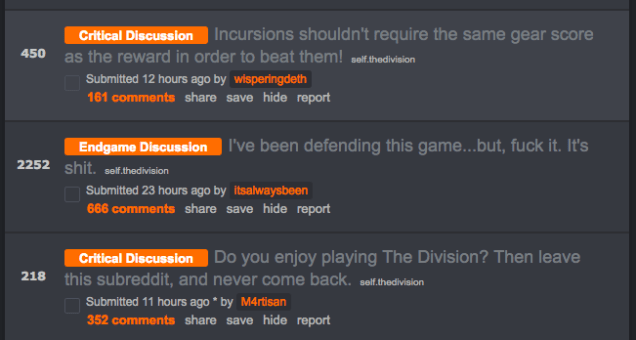
“In an online community with an always-on live multiplayer game, there is no hiding from feedback and, in fact, we embrace it,” Pana said. “And while we certainly do our best to look past the emotional and charged conversations to focus on what we’re able to change and improve, we’d be lying if we didn’t admit that was tough to filter through the feedback when things weren’t going as well as we would have liked.”
As catalysing as Underground was for mobilising fan unrest, it was also clarifying to the developers. It left them with the unavoidable conclusion that something had gone wrong.
“The Underground was the first endgame content that tried to service all the spectrum of our very large audience at once, from the solo casual players to the four-man-elite squad,” said Gilles Matouba, the game director at Reflections, the studio that handled much of the development of the Underground expansion. “Because of its nature, it ended up magnifying a lot of the balancing issues that were already known around at the time, like the lack of difficulty granularity or the most extreme bullet-spongeing enemies.”
Among the problems Underground highlighted was that many of The Division’s endgame tasks required players to be really powerful, but to be sufficiently powerful they’d need to have the calibre of loot only provided to players who cleared those very endgame tasks. To get around this, players had to grind or venture into the controversial Dark Zone and take their chances in a wilderness of backstabbing rogue players. Fewer and fewer people were having fun. More and more people were bailing.
Ubisoft, realising they had a big problem, delayed the game’s next two expansions and shifted development focus to another new update.
“We realised that we needed the Update 1.4 in order to bring the game back to full health and prepare us and the players for Survival and Last Stand,” Pana said, referring to two more announced expansions. “For us, it was assessing where the game was at, what needed to be fixed in order for us to be confident and build faith in the community and then prioritise the key areas that needed to be improved.”
Pana said 1.4 was developed by the same core team that has been on the game from the start. When asked if they’d looked at Diablo III, another loot-driven game that enjoyed the exact kind of post-release patch-driven turnaround that the Division’s creators are striving for, he didn’t mention the game and instead spoke of the fans and his own team.
“We looked what we could do to create a better system that would make more sense for players and keep a balanced game all around,” he said. “From the information we gathered from players as well as a few ideas that we kicked around internally, we came up with something we believe will improve the game on multiple levels.”
In attempting a turnaround for the game, Ubisoft has flown hardcore Division players to Massive’s offices in Sweden. The studio also just ran a public test server for several weeks, giving all players a chance to test various balance changes being applied even as the developers tweaked them.
Fans have been positive about a lot of this, celebrating the introduction of tiered world-difficulty states, the introduction of more ways to get loot, and the alleviation of the loot-acquisition catch-22. Weekly tweaks produced new feedback on the subreddit — maybe the game was now giving out too much loot, or being too easy. One player articulated the concern that the game’s developers were only operating in extremes, swinging the pendulum too far one way and then the next.
But the vibe has been far more positive, as the game’s creators have posted incredibly granular posts outlining comprehensive changes to nearly every system in the game. The patch notes for 1.4 are long and full of very promising tweaks.
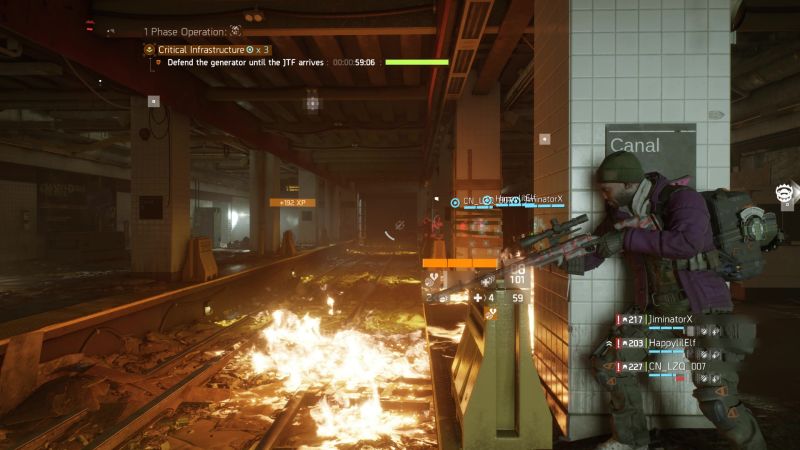
Underground gameplay, pre-1.4
“With update 1.4, we have created a fun end game for everyone with a clear and granular progression whether you play solo or in a group,” Pana said. “Any activity has a chance of rewarding you with the best weapons and equipment so you can play more of the activities you like and progress at your own pace. Actually, with the field proficiency, just gathering experience points after the level 30 will eventually reward you with sealed caches containing loot based on your gear score.”
“Good news,” Matouba, the Underground director, added. The problems that people had with Underground, those bullet sponge enemies and whatnot are, he said, “at the center of the incoming 1.4 update.”
Pana said the team has been encouraged by how much time players have spent on the test server. Ubisoft wouldn’t talk numbers, but he said the public test server hit max capacity right away. “We had to increase this maximum capacity in order to reduce the queuing time,” he said. “It was very exciting to see so many players eager to try the 1.4 update and spending so much time on the PTS.”
Too Late?
As raucous as it’s all been, The Division’s developers say the frank feedback from fans has been worth it. “Our greatest takeaway that we’ve learned in working on The Division is that the player community is truly the heart and soul of the game,” Pana said. “Being able to build a longstanding relationship was vital to the game’s success as well as helping it get through the tough times as well.”
Asked if he had advice for other developers and fans, he suggested game creators listen to their players. “We’d say, ‘Get folks in early, have them play, continue to build a trusting yet brutally honest rapport.’”
And for the players? “I’d say keep providing feedback and ideas. This is all part of the process on maintaining the health and vibrancy for a live game. While we’d love for all of the conversations about the game to be positive, we also realise that candid feedback from a dedicated community is invaluable.”
Struggling games rarely rebound. For every Diablo III or resurgent Rainbow Six Siege, there are many more that stagger, fall and stay down. Players get fed up. The game proves to be fundamentally unpleasant. New games come out and people move on. As much smart work now seems to have been done to repair The Division, it could be too late.
“I don’t feel that way, for a number of reasons,” Bronjemark said. We have so many dedicated players who are coming back to play day after day, week after week, and with Update 1.4 I believe we are finally able to remove those elements of frustration that they have been voicing to us. We also have two new major updates coming: Survival and Last Stand that will bring a lot of new diversity to the game experience. And we won’t stop there. As a team we are dedicated to continue to support the game for a long time to come.”
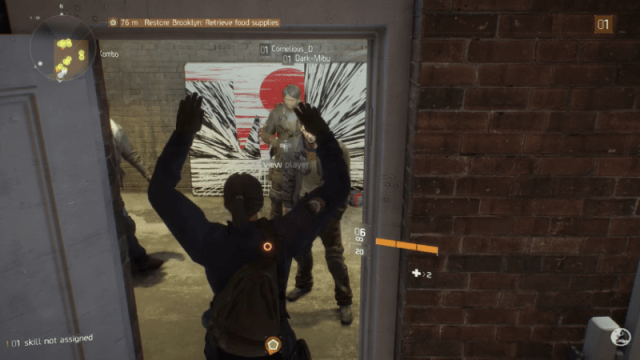
Comments
10 responses to “The Division’s Rocky Road”
I really enjoyed the Division, far from perfect but after you completed the game there was just so little do if you didnt want to go into the toxic wastelands of the Dead Zone. When I played on PC i was able to mostly level to the cap of the dark zone alone. Sure there were always a few jerks but for the most part as long as I was careful it was still fun.
Just been recently playing on PS4 cos my PC is a tad sick and was given a copy as a present but now days the Dark Zone is just massively trash. Roving bands of sad desperate people hunting in groups of four, killing solo players in the beginning block or so and IF you manage to extract stuff they just come along at the last second and cut the line. No thanks. Watching people being pathetic to others and call it a game. There needs to be an op out mechanic even at the cost of loot or xp or something. Even when grouping everyone else seems so overpowered they kill you in a hit or so.
At the very least when you finish the game the whole PVE should have become a hard mode map.
Good news, when you finish the PvE in 1.4 you get to choose the world tier level of the PvE enemies (30, 31, 32 or 33). They’ll all drop the same grade of loot, but higher tiers will drop proportionally more, so you can PvE to your hearts content at your chosen difficulty and still get items that will progress your character.
oh good, I have had a chance to go through all the patch notes so far.
I agree it was very good and fun to play once i got to the end game tho. shame about this game.
I pretty much gave up during 1.3 given the changes in development for 1.4. Super keen to try out 1.4 but I’m a little worried too many people will have already given up for good and won’t even be bothered to try it out again. Releasing the patch just as BF1 came out (and soon Titanfall 2) probably isn’t going to help bring the numbers back up either – I’m a big fan of the Division but BF1 is just amazing.
I really enjoyed the division as a single player game.
I tried playing multiplayer once but since im a casual gamer there was a large difference in gear / skill for me to find it enjoyable.
I still highly rate it as a single player game
I have stuck with the game through all the tough times and there is no doubt 1.3 was complete rubbish. I know exactly why a lot of people left the game, in fact I’ve bounced in and out myself a bit.
However, If you enjoyed the Division early on but bailed due to end game, go try 1.4! it has addressed/fixed so many (dare I say most?) of the core frustrations that were the cause of people leaving. The end game has been completely revamped, everything from gear sets, loot drops and a clearer progression path from a new lvl 30 to a fully geared 30, to lower time to kill and longer time to be killed. everything (with the possible exception of incursions) can be completed as a solo player and scales up well to what ever number group you’re running.
The open world (now dubbed the Light Zone) will be a fun and viable place to roam around solo or in a group once you reach level 30. You can now manually set the world tier which will determine the level of every enemy AI, plus the named bosses respawn and you can get all the best loot/gear without ever venturing into the dreaded Dark zone.
If however, you did enjoy the Dark zone before it became a cesspool of filth, because of the way everything has been re-designed, the gap between casual player and min/maxed player has shrunk considerably, meaning you have a much better chance against the shit-bucket veterans. There is even a specific DZ gearset that has benefits for going rogue, or benefits for not going rogue (Including no loss of funds or progression for dying in DZ).
I think it’s also important to remember that whilst you will hear people use the Steam charts to prove the game is “Dead”, steam only shows a small piece of the pie. It doesn’t AFAIK include people who didn’t buy the Division through steam, but it also completely neglects console numbers. As a PS4 player, I have never had a problem matchmaking for any missions at any level with wait times being almost immediate. Every safe house, every underground and even every dark zone is always full of people. It sure doesn’t feel dead over on PS4.
TL:DR – From someone who has followed and or played the game from launch until now, who openly criticized the game for the abysmal state it got into and had some long absences from the game during 1.3, Go download the 1.4 update and give it another crack, it might just win you back, especially if you’ve already bought it.
Played the beta, thought it looked good. Bought it at release, played for a week and haven’t touched it since.
The game was just lacking fun for me. Too much rinse and repeat the same god damn thing over and over. There’s games that have grinding and then there are grinding games….this was just a pure boring, frustrating grind.
I’ve moved onto other games now, still playing WoW Legion – a game that requires grinding but is fun while doing it. The Division had its chance and blew it. I won’t be going back.
The Division along with No Man’s Sky were my two biggest disappointments of 2016. The game play in The Division once finished, was very rinse and repeat. I had no interest in the Dark Zone as I’d get hammered everytime by other players who just wanted to grief, even whilst set with high lvl gear. Cheating was rife (Almost as bad as Day Z), getting sniped across the map repeatedly is not fun. Ubi just took too long to address the cheating IMO, so lost a lot of faith from those who’d have otherwise stayed.
Pretty much all of my friends who brought this shelved it less than 2 months later. Got burnt by this game, will struggle to invest more time in this.
I didn’t even finish the Division and finally traded it just the other day (towards BF1). Honestly I didn’t find a single aspect of it fun and it just felt like a grind the entire time. I’d rather play Borderlands or Vegas 2, not a weird mix of both.
Other way around – same amount of gear drops but world tier determines the grade of loot. (Tier 1 = 163/lvl 30 mods, Tier 2 = 182/lvl 31 mods, Tier 3 = 204/lvl 32 mods & Tier 4 = 229/lvl 33 mods)